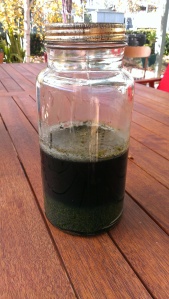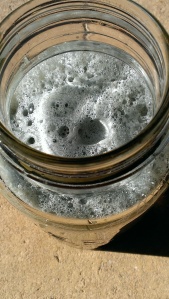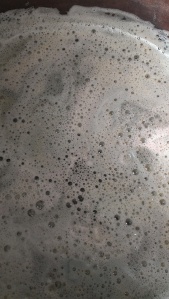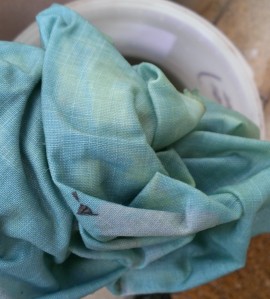My second experiment with Indigofera Australis was a hydrospulphite vat. Robyn Heywood from the Victorian Handspinners and Weavers Guild has made her experiments with Indigofera Australis available online. I was delighted to be able to see the records and samples of the Victorian Handspinners and Weavers dyeing group at their Guild Rooms when I was in Melbourne last year. It was really inspiring to see the variety of methods they had used and the range of colours they had achieved.
Robyn Heywood has trialled this method as well as the cold vinegar method and provided instructions. So, since I still had some hydrosulphite left from my last indigo vat, I decided to try it. Robyn Heywood soaked the leaves… apparently it is too much to expect that I would follow instructions exactly. I blended them and left to soak for a couple of days. Here they are 18 hours later.
Robyn’s proposal was to leave them in a warm place. I created one the first night by sitting my vat in a bucket of warm water, and then since the days aren’t warm right now (17C maximum)– the best I could do was a sunny spot. 48 hours later–or so–I started in on the preparation of the vat. First, I sieved out the plant matter. Then, added washing soda. Now for aeration. I went with the trusty blender method, which I was sure would introduce a lot of air. Before:
After:
I watched sceptically, but indeed, the bubbles did turn from green to bluish! I prepared a hot water bath to raise the temperature of my vat. I put the jar into it. I turned away, and a few minutes later there was an almighty crack as the jar came apart. Rude words were used. On the down side, I now had glass shards I couldn’t see in my dye; evidence of poor judgment on my part; a broken jar and a clean up job. My dye bath had at least 1.5 litres of water added to it, so probably now had three times the amount of water I had decided on (that sounded like a weak vat to me!) And it was now in a stainless steel dyepot, along with whatever contaminants it contained after being rinsed out. On the up side, the bath got to 50C almost immediately and the bubbles were still going blue.
‘Press on, how do I know what will happen?’ I thought. ‘Don’t be wasting that precious dyestuff’, I thought. I got out my trusty milk crate/felted blanket dyebath insulating system, filled up one hot water bottle which promptly sprung a leak; filled up another hot water bottle, sprinkled on the dye run remover, applied hot water bottle and felt blanket to vat and walked away. ‘Que sera, sera and all that’, I said, sighing. Well, I need not have sighed, because the vat turned a vivid yellow. In went some silk/cotton thread and a piece of hemp fabric.
They came out bright yellow and turned green and then blue-ish almost immediately.
And so, to re-dipping, gleefully (and repeatedly). Yield: several lengths of silk thread in shades of blue and grey, and a piece of pale blue fabric. I have plans for them. I am not sure whether this amount of leaf would always have produced a pale shade and to what extent my accidentally diluted dyebath contributed. But, some blue resulted, and that part is excellent!








Boo on the glass cracking! At least your winter is warmer than our summer, it was 13 C here yesterday….
LikeLike
That is a chilly summer! We get up above 45C here in summer which is a different kind of difficulty… I think I should have realised that if there was cold water inside the glass and warm water outside… problems would result. Sigh.
LikeLike
Was it evil of me that I giggled at your tale of woe? Still, all’s well that ends well – that’s some rather splendid blue and a nice pleasing grey you have there!
LikeLike
Well, maybe it was evil, but I laughed at your laughing, so clearly enough time has passed for it to be funny! Thanks!
LikeLike
Thankyou for sharing your experiments (jar of woe notwithstanding!). It’s nice to know blue can be yielded from this plant! I found some plants for the first time the other day in Melbourne. I will have to experiment with them when I visit again. Here in the Top End I’m fortunate enough to have Indigofera tinctoria running wild around the traps, and that of course yields up blue fairly readily.
LikeLike
Jar of woe is what it was 🙂 There is no doubt the plant can give blue–but if you have true indigo available, I think it is clear that it contains more dyestuff. I didn’t know it was growing as a weed anywhere, even the top end! Sounds like fun…
LikeLike